Days 32 through 40, Astorga to Sarria, ~165.1km/102.6mi
On to the third and final phase of the Camino, the most heavily trafficked and most popular phase,known as the spiritual, or “Soul Phase.”
The Camino de Santiago is for many, still a Christian pilgrimage, as was its origin over 900 years ago. So when I announced my plans to walk it, I got a few raised eyebrows. While I do hold strong views about spirituality, I have never been known to be religious. But I find with Spain, just as with Mexico, one can be invited and included for the cultural aspect without the conversion. In these instances, the cultural aspect almost becomes spiritual.
While walking in circles around the local community park last spring trying to “train” for the Camino, I listened to the audio book for inspiration, “The Art of Pilgrimage” by Phil Cousineau. The author suggests that anyone who has set out on a quest to see a religious monument or ancient historic site, whether it be Machu Picchu in Peru, the Mayans pyramids of Mexico, or even the Vietnam Memorial, has embarked on a pilgrimage. Webster defines a pilgrimage as “a journey to a shrine or sacred place.” I tend to think along the lines of the famous architect Frank Lloyd Wright, who said, “I attend the greatest of all Churches. I put a capital N on Nature, and call it my Church.” So it was easy for me to slide into this third phase of the Camino, the most beautiful section yet.
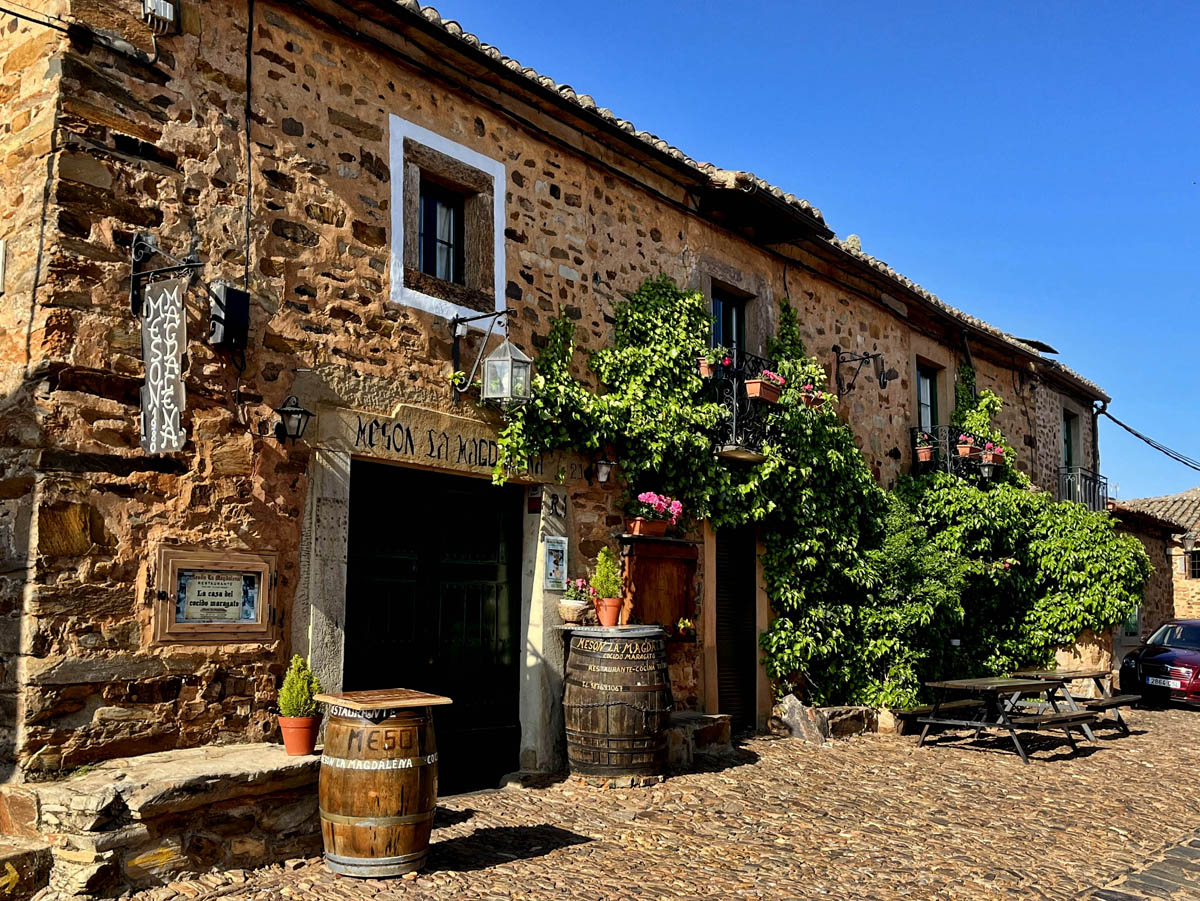
I took an alternate path through the small hamlet of Castrillo De Los Polvazares. Though it added a couple of miles to my day, I was glad I did. All the buildings were made from stone, and the streets were ancient cobblestone. I only saw two other people in the entire town.
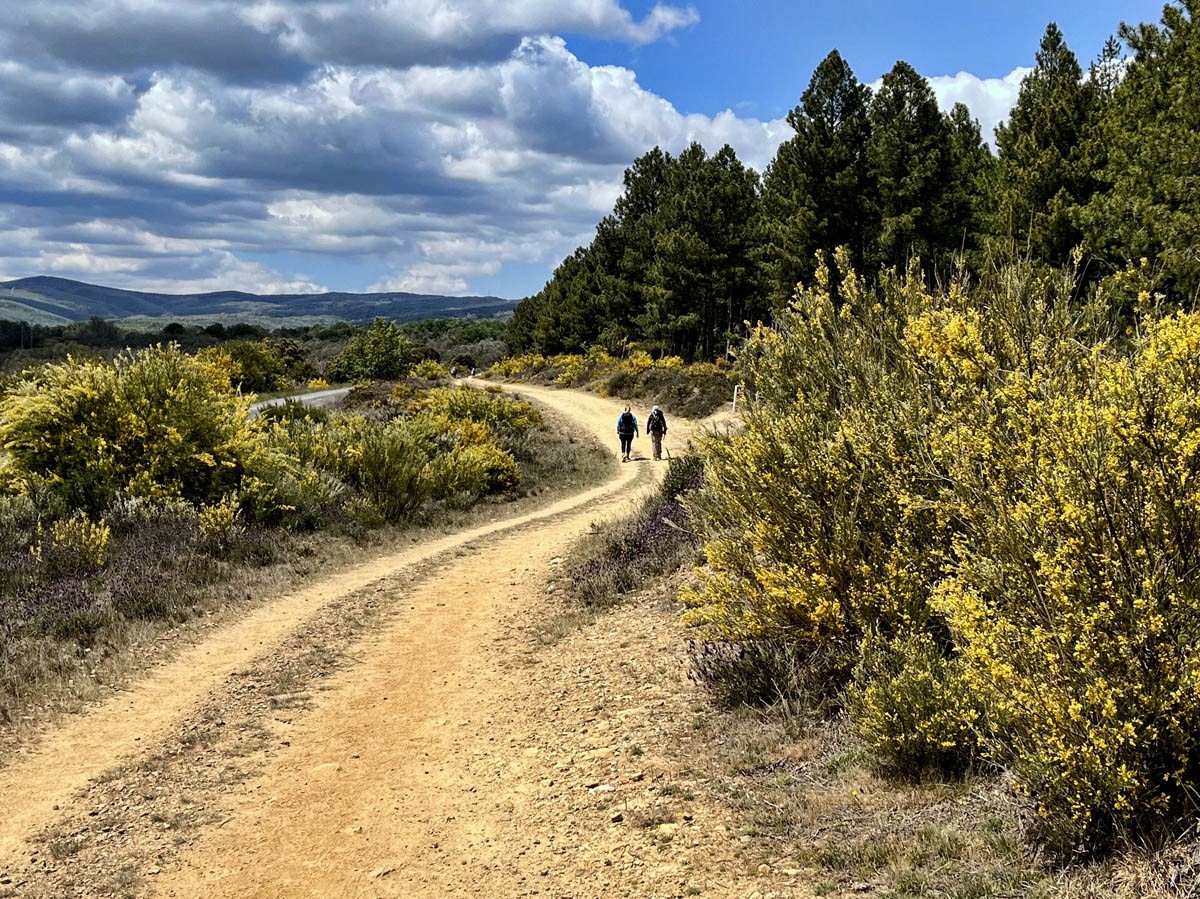
Between Astorga and Samos, I encountered an abundance of trees and bushes laden with yellow flowers. I was told it is Spanish Broom.
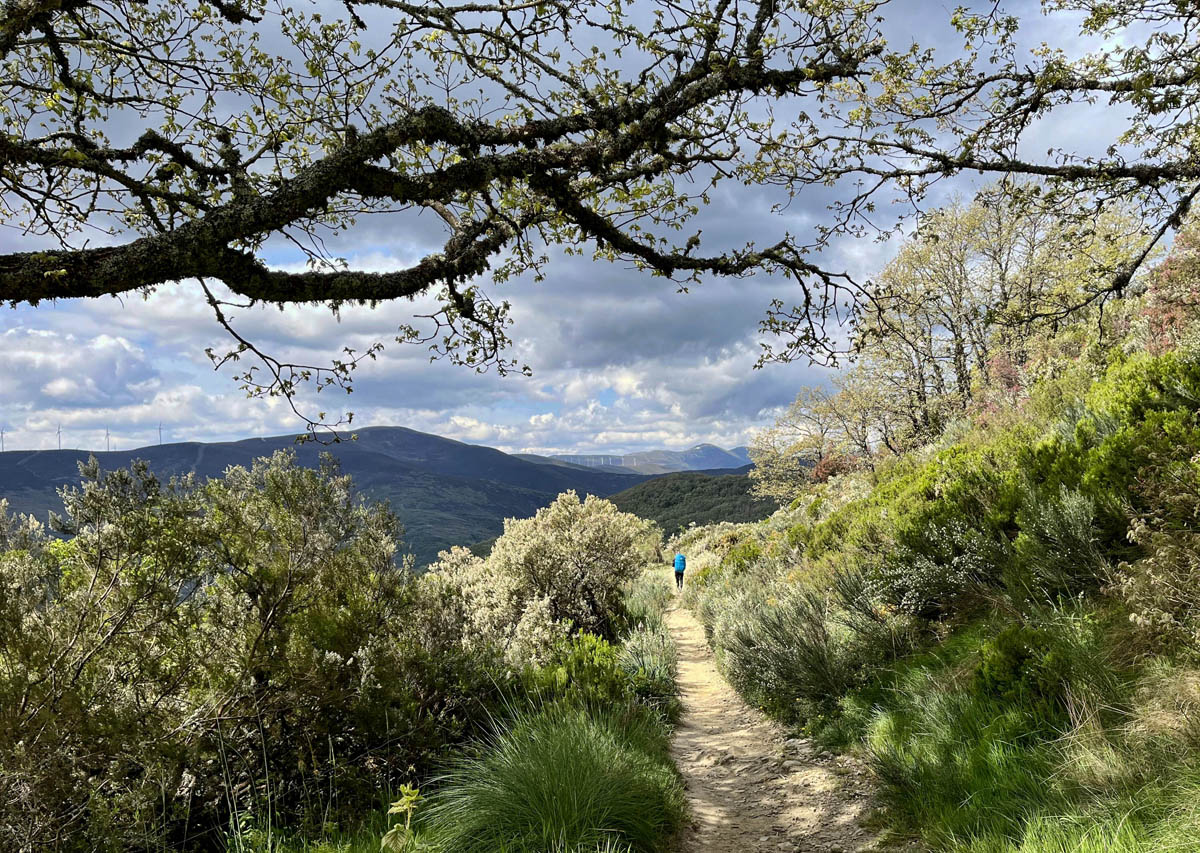
Along this section, I walked through some of the most beautiful territory yet. The trail followed the ridge line high up over the valley, and it was lined with bushes covered in pink, yellow, orange, and white tiny flowers all along the trail.

At the top of the mountain pass, there was a food truck playing beautiful acoustic Spanish guitar music. They even had a wood burning fireplace, as it was quite chilly at the top.
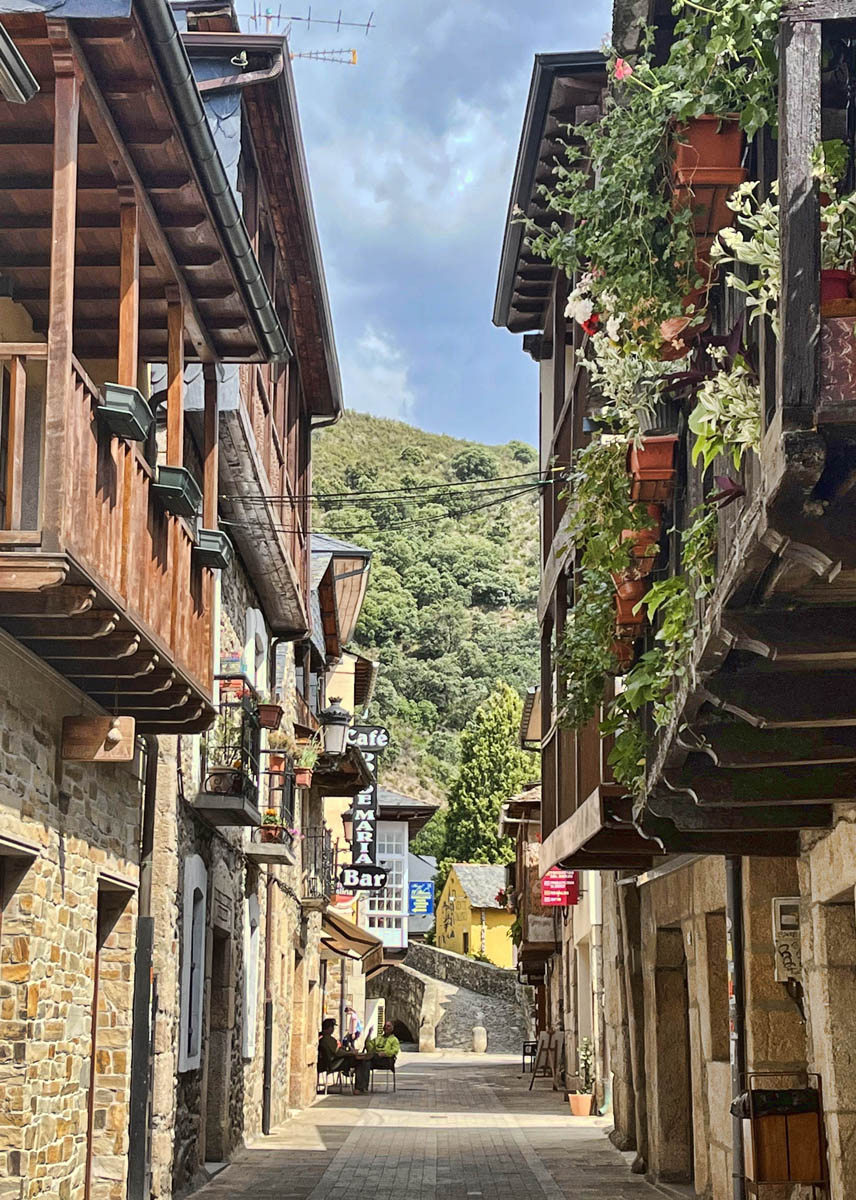
Coming down from the mountain, I was looking forward to my overnight in this adorable little medieval mountain village, Moliniseca.

Puente Romano, or Roman Bridge crossing the Meruelo River.

You wouldn’t believe how much “stuff” they manage to cram into these little mercados, often the only source for provisions in the smaller villages.
Having left the plains behind, the path begins to climb steadily across the mountain range of Leon, until it enters Galacia, one of the most beautiful stretches along the Camino. The region of Galicia receives the highest amount of rainfall along the Camino (though I was still humming “Have you ever seen the rain?”) The verdant hills are blanketed by green grasses and an abundance of wildflowers. Fields of daises spill down into the valleys. Bushes are covered in tiny flowers in colors of purple, white and pink, while fragrant lavender fields instill a sense of calm. And the path often follows alongside some small mountain stream.
One of my favorite Camino moments was walking through a deserted village along one of these streams, when I received a “What’s App” message from Rebecca, who was up ahead. The message said she had found a stream, and had stopped to soak her feet for a bit in the river. Once I caught up to her, I pulled off my shoes and socks, and sat down to join her. The ice cold water felt so therapeutic on my hot, tired feet!
I remarked to Rebecca that it’s times like these, lazing alongside a river that I almost forget I am walking the Camino. But then she replied, “it’s times like this that ARE the Camino!” We sat on the large stones, our feet dangling in the icy therapeutic water as we watched pilgrims march down the road behind us, never breaking stride. “Click clack, click clack” went their walking sticks as they raced past in a hurry to get to their next destination, missing in our opinion, the best part of the Camino! And the purpose of my “pilgrimage.” Soul phase, indeed.

This beautiful old chestnut tree outside of Triacastela is believed to be 850 years old, It’s deserving of a hug!

Rebecca from Chicago, giving her feet a well deserved break. I decide to join her for a cooling, refreshing foot soak!
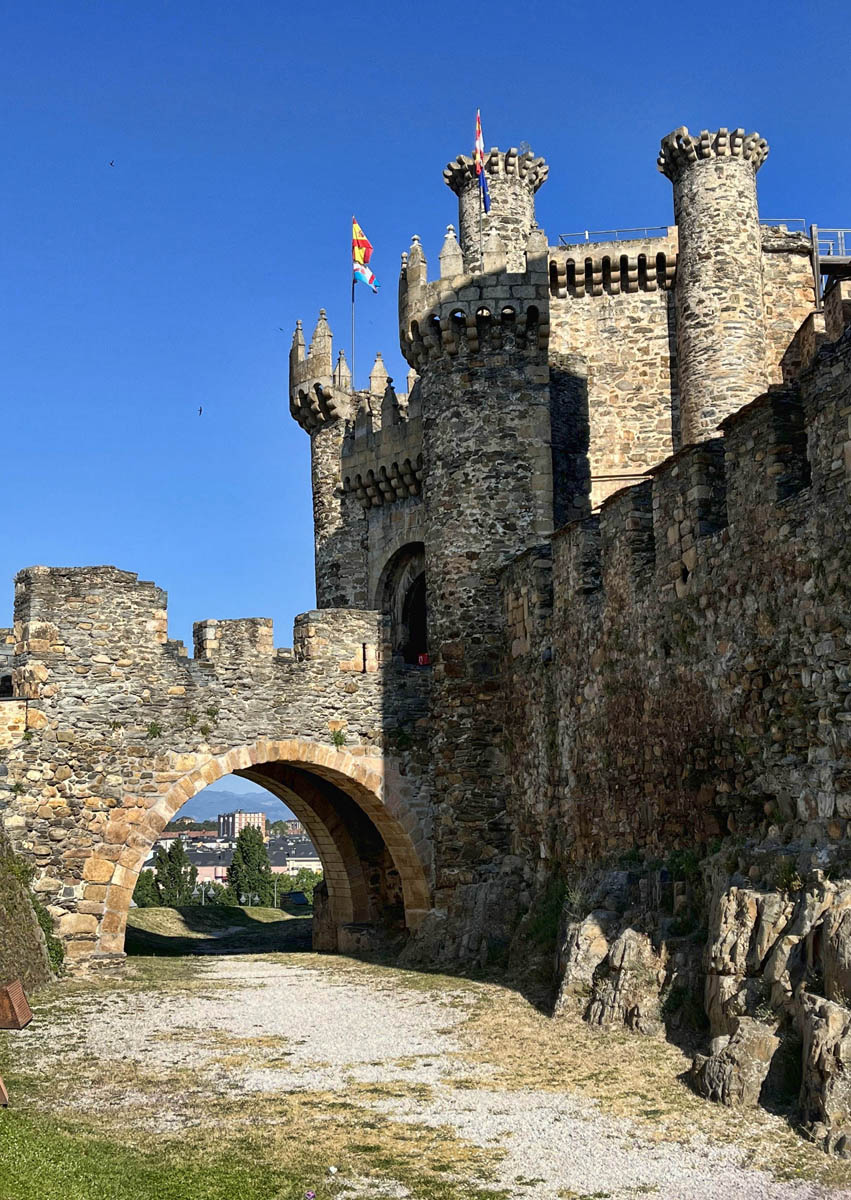
Reaching the town of Ponferrada where there is a Templar’s castle, Los Templarios Castle, complete with moat and drawbridge dating back to the 12 century. I stopped for a quick look inside.

Ponferrada is a lovely town. It’s also where the Camino splits. Camino de Invierno, lesser known option, veers off to avoid the crowds that can occur during the last stages of the Camino Francés.

Another alternative diversion from the main path through rolling hills covered in vineyards and cherry trees. Legend has it a pilgrim brought with him from France some plantings of the Franc grape, which was the start of that type of wine in this region.

This was by far my favorite “Pilgrim’s Dinner.” The guy on the left, David, runs an albergue called “Vagabond Vieiras.” Originally from LA, he operates portable pizza ovens at concert venues during the Camino off season. Best pizza since I left the US!

Beautiful “panaderia”, or bakery as the trail begins to climb from the Rio Valcarce.
Not only does the abundance of beauty in nature play a big role in this third of the three phases. the “soul phase,” but there are also number of milestones associated with spirituality. Perhaps the most celebrated of these (with the exception of Santiago itself) is Cruz de Ferro. Little more than a small iron cross atop a wooden pole, over the years it has grown in significance as pilgrims each bring a stone to leave behind atop the pile of stones to represent their burdens left behind on the Camino. It’s also a place to leave a stone or token in memoriam.
I literally gasped when I saw it. Not because of the monument itself, which was anything but majestic. But more because of the many times over the last 30 days when I have thought about turning around and saying “fuggetaboutit!!!” But each time I would ask myself how would I feel if I had carried that stone with me for two months, contemplating the significance I had given to it, only to bail out before I had the chance to leave it for its intended purpose.

Though the Cruz de Ferro monument is little more than a massive pile of stones around a pole with a small cross on top, it represents so many burdens carried so far, left behind in hopes that they will be lifted. As the highest point on the Camino Francés, it’s a bit of a tough climb physically as well as emotionally to reach this point. Carrying my stone from home with intent of leaving it at this milestone was one of the things that kept me moving onward.
Another moving experience along the “Soul phase” came about during my overnight stop at the tiny mountain hamlet of O Cebrerio, likely my favorite overnight along the Camino. This stop has so few accommodations, it books up far in advance. Again, thanks to Nina who recommended I should try to overnight here, I put in a few extra hours time on the telephone, and finally found a room. They don’t take credit cards, however, and she would only hold it until 3:00pm. This meant an early start, and huffing and puffing up a hill so steep, some even choose to hire horses to the top. I am pleased to report I made it with time enough for lunch.
O Cebrerio is home to Santa María la Real, founded in the year 836, purported to be the oldest church along the Camino Francés. In ancient times, the church bells aided in guiding the pilgrims through the fog that often enshrouds this mountain top town.
I attended my first “Pilgrim’s blessing” here, which happens every night at 7:00pm. The small church was lit by tall red candles flickering along the walls and entry, along with soft organ music. The priest invited all pilgrims to come forward and form a big circle around the pulpit. He asked for a representative from each of the different countries present to read the pilgrims blessing in their native language. It was very moving and inspirational to stand among pilgrims representing so many different nations, all with the intent to reach a common goal. After the readings, we were each given a small stone with a yellow arrow painted, and encouraged to follow the ancient term, “Ultreaia,” meaning “Onward and Beyond!”

The climb leads to another charming mountain hamlet of O Cebreiro, and likely my favorite overnight along the Camino. Touristy, some might say, but oh, once the daytrippers leave to go back down the mountain, it’s worth the wait!
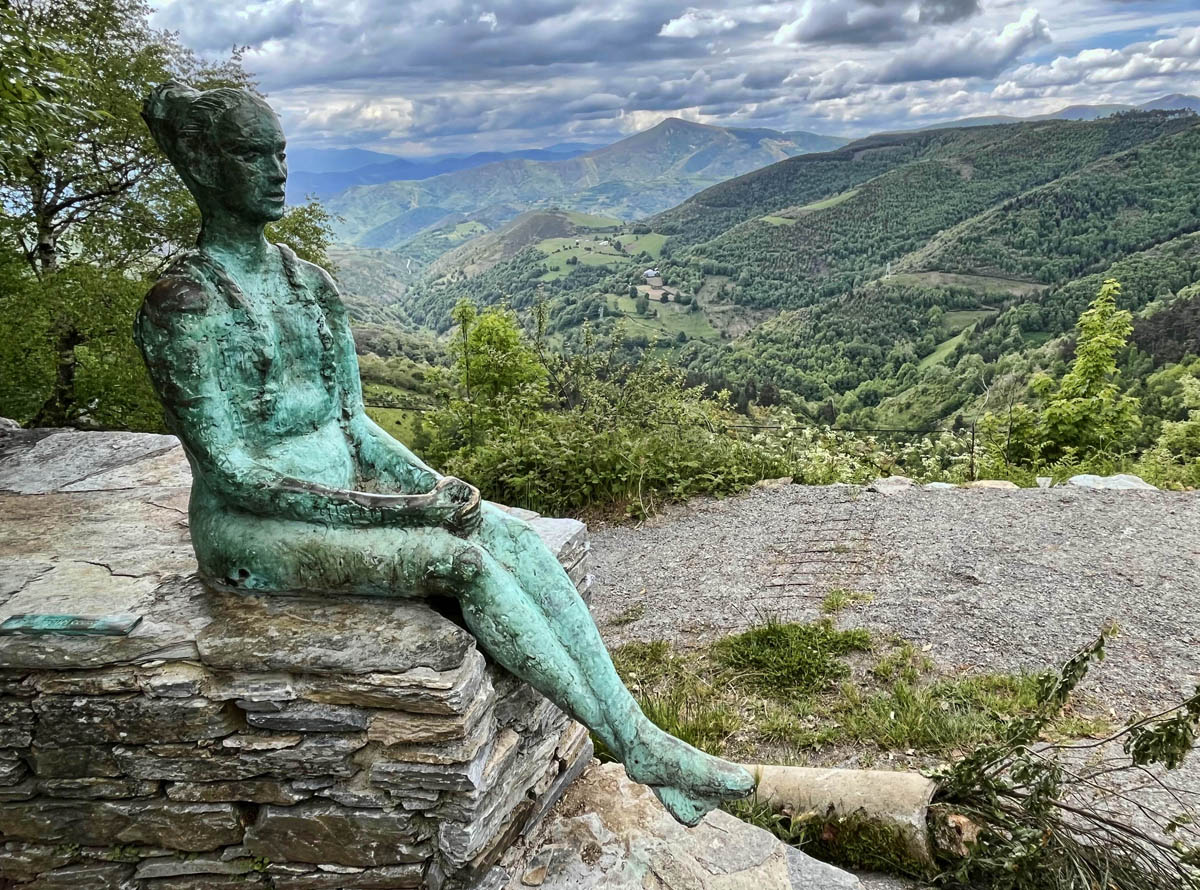
First indicator you have reached O Cebrerio is this beautiful verdigris statue known as “the Little Pilgrim” wearing a backpack. Interestingly enough, the only statue along the Camino dedicated to pilgrims that was female.
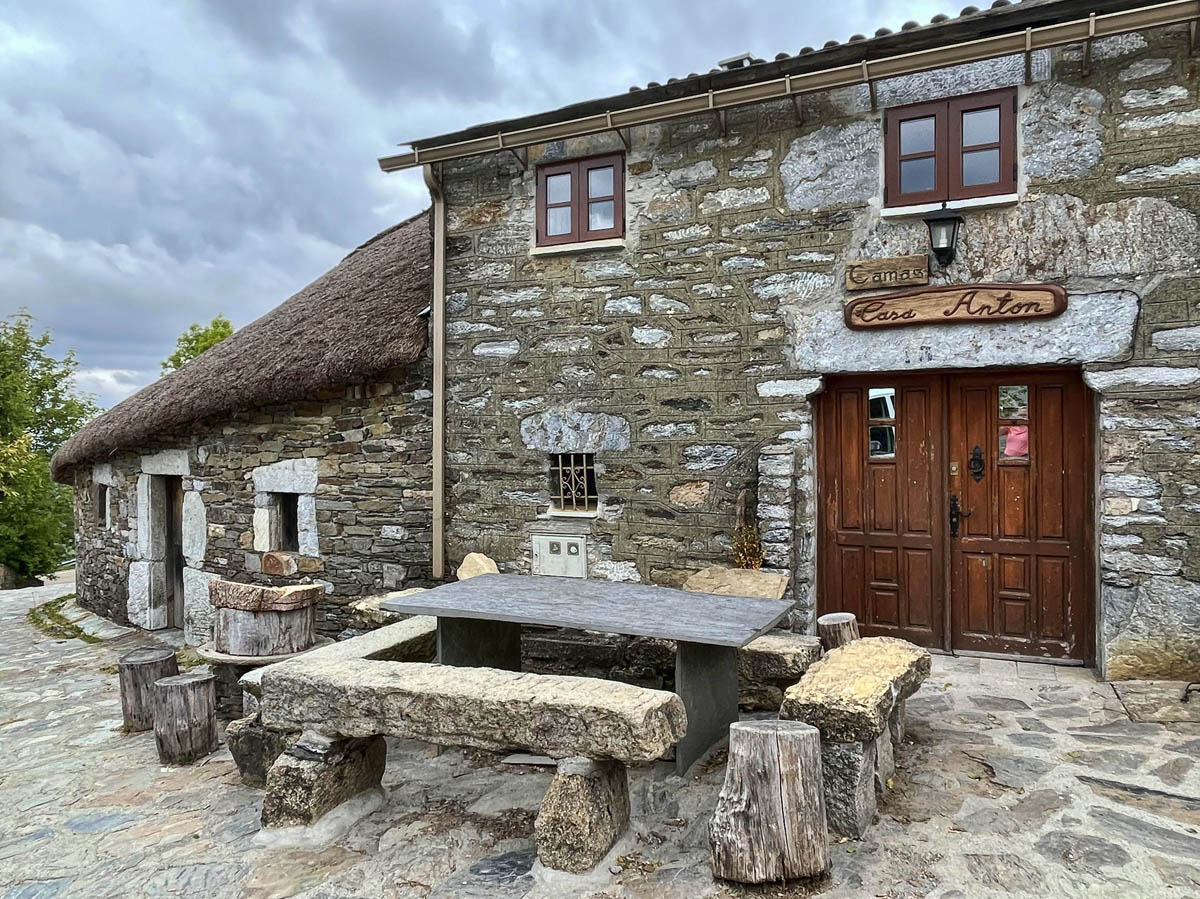
To quote travel guru Rick Steves, “Perched on a high ridge, the impossibly quaint hobbit hamlet of O Cebreiro welcomes visitors to Galicia — a hilly, damp, green region in northwest Spain that feels vaguely Irish. O Cebreiro is a time-warp connection to an uncomplicated, almost prehistoric past, when people lived very close to nature in stone igloos with thatched roofs.”
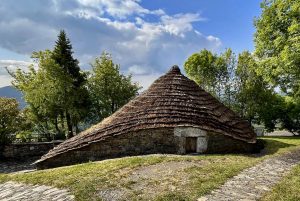
Villagers lived in these little stone huts called “pallozas” until as recently as the 1960s.

This palloza, or thatched roof hut has been converted into a tienda, or market. They carry a surprisingly large inventory, including Magnum ice cream bars and Diet Coke! Of course, there is beer and coffee for addictions other than mine.
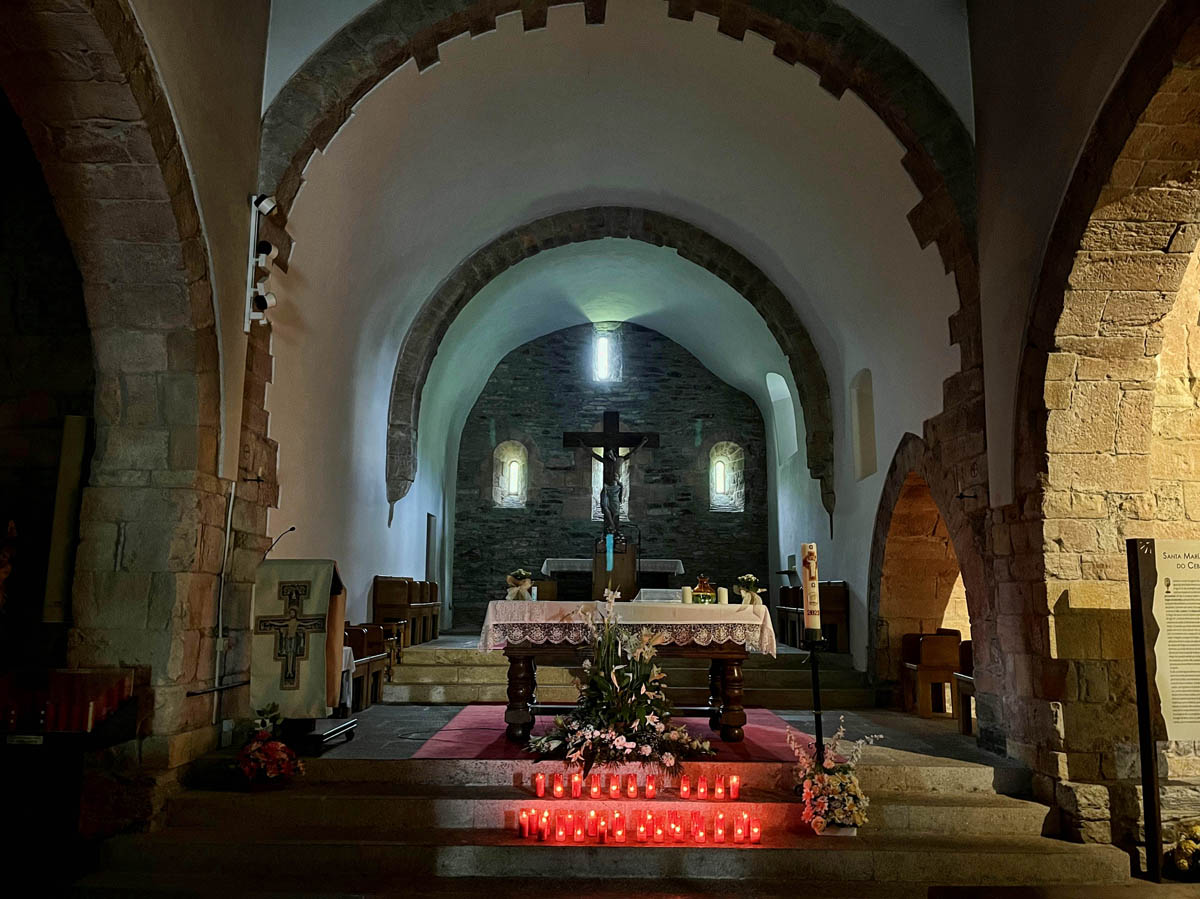
But the small village is probably best known for its church, Santa María la Real, founded in the year 836. It’s supposedly the oldest church on the entire Camino. Each night, there is a Pilgrim’s Mass held at 7:00pm. I am not religious by any means, but this was one of the most evocative services I have yet to attend.
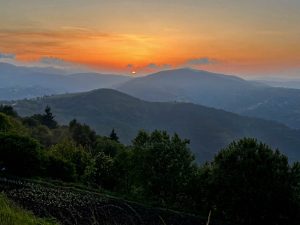
My one night in O Cebreiro was capped by a beautiful sunset.
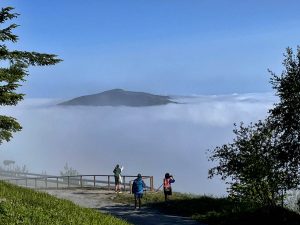
I awoke the next morning literally above the clouds!
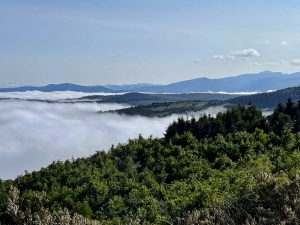
The clouds were dreamy almost the entire day.

Even the cows think so…see behind them where the clouds look like a waterfall, pouring down from the hills into the valley.

Fields of daisies spill down into the valley.
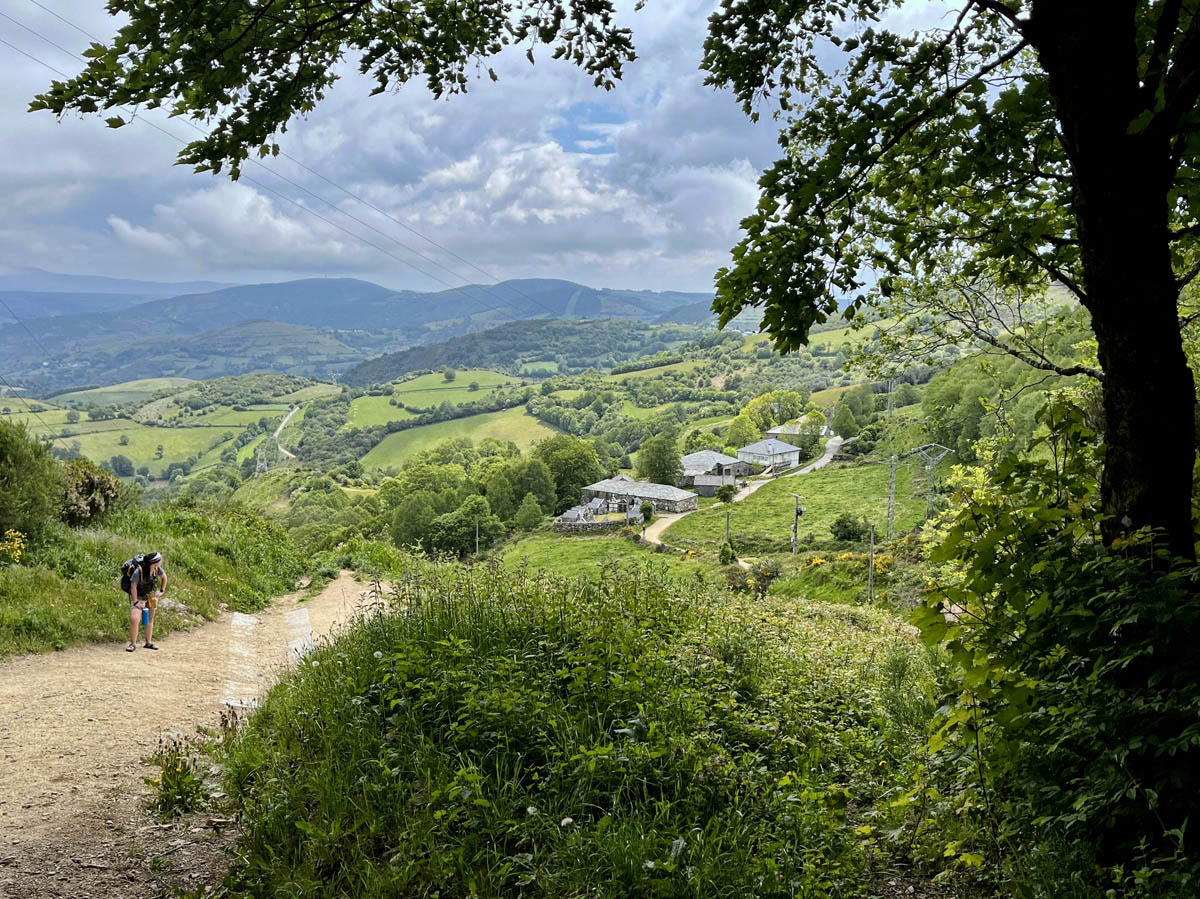
Note this young woman in the lower left side of the frame. Hands on her knees, looking back over her shoulder down the steep hill, her stance says it all. There is very little level terrain along the Camino. Lots of ups and downs.

Here is what “laundry day” looks like, enjoying a glass of Albariño wine, for which the region is known. The soft white cheese, Queixo de Cebreiro, is locally produced by families in the town of Fonfria. It’s made entirely from cow’s milk with no preservatives or additives. The local honey on top made for a lovely afternoon snack while waiting on the spin cycle!

This region has a lot of Spanish slate roofs. The tiles are disc-like, and they intercept along the top in a jagged pattern reminiscent of dragon’s scales.
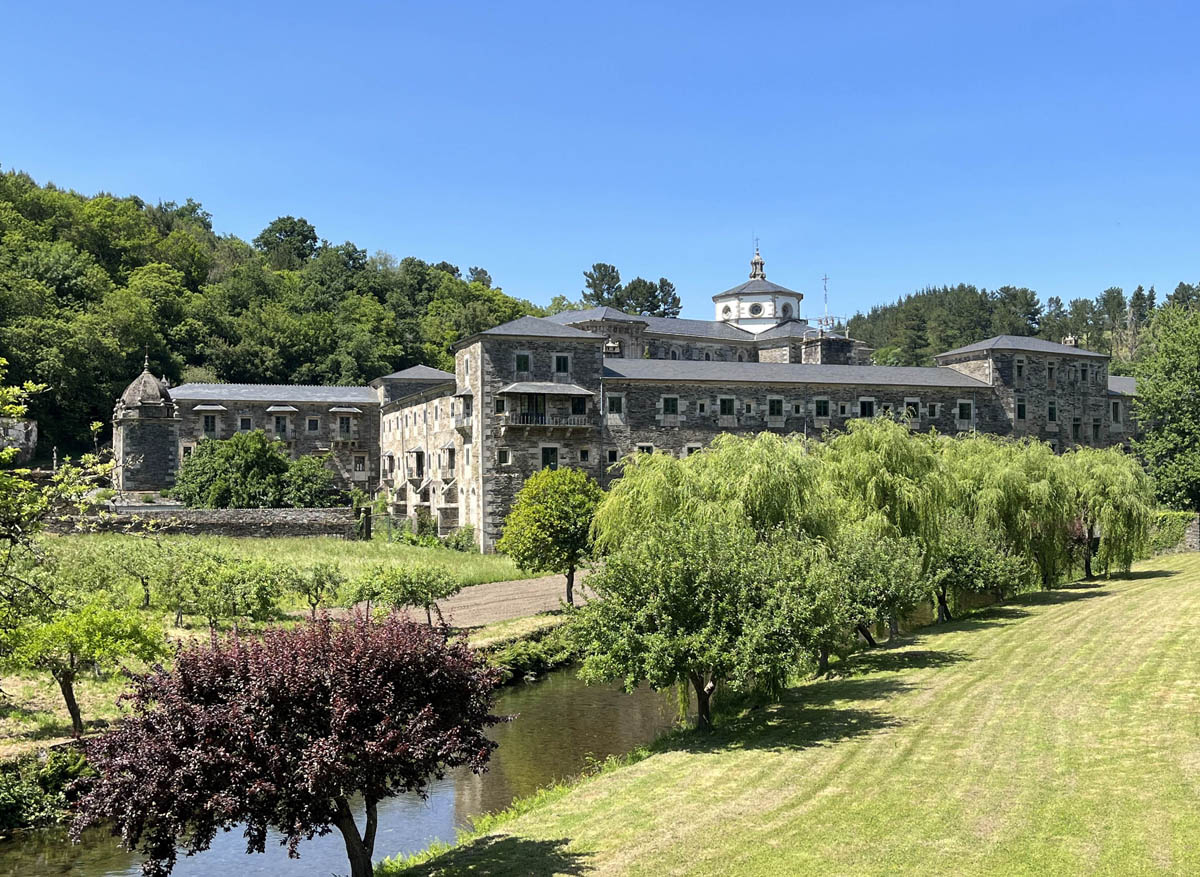
Rebecca and I decide to take the more rambling variant through Samos, and meet up to tour the Monastery of San Xulián in Samos, founded in the 6th century. It’s still an active Benedictine monastery, with the tours being led by monks.

The walls of the monastery were all painted with murals. While I took dozens of photos, this scene over a doorway was my favorite.
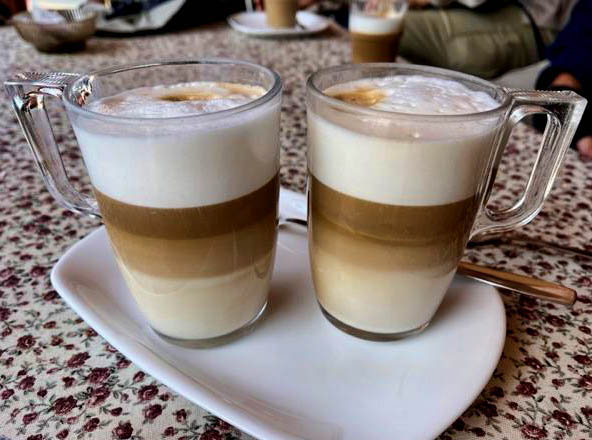
Let no day be complete without Spain’s famous Cafe con Leche!
Once again, I have failed to condense this third and final phase down into one blog post, because things are about to make another drastic change yet again. Leaving Samos, my next stop would be Sarria, the closest town to the final 100 kilometers, the minimum distance that one must walk to receive the compostela, or certificate to prove that one has “done” the Camino. It doesn’t matter how many miles you walked before Sarria. You could have come all the way from Jerusalem. But you must walk that last 100 km stretch to qualify for your “Camino diploma.” (200 km if by bicycle.) I just have too much to say about this final 100 km, so another “to be continued” is required. I promise I will wrap this up soon for both our sakes!
Meanwhile, here’s a little excerpt from Joni that kept running on continual loop through my head on this final phase…
“California” ~ Joni Mitchell
So I bought me a ticket
I got a plane to Spain
Went to a party down a red dirt road
There were lots of pretty people there
Reading Rolling Stone, reading Vogue
They said, “How long can you hang around?”
I said a week, maybe two
Just until my skin turns brown
Then I’m going home to California
California, I’m coming home
Oh, will you take me as I am?
Strung out on another man
California, I’m coming home
Oh, it gets so lonely
When you’re walking
And the streets are full of strangers
All the news of home you read
More about the war
And the bloody changes
Oh, will you take me as I am?
Will you take me as I am?
Mmm, mmm
Take me as I am, mmm

Incredibly evocative and beautiful. Thanks!
I’m so happy to see we’re not finished yet! Thank you for the opportunity to see and hear about this amazing journey.
Kat
Oh, Suzanne, this last section is so gorgeous. The green hills and mountains, flowers, and amazingly beautiful small towns with their unique structures just blew me away. This area I would like to see. Thanks so much for sharing so many beautiful photos.
I just love the way you tell a story! The ‘verdant hills’ carries so much more weight than ‘the hills were green’. As always your wonderful photos show off your story.
Almost there! Buen Camino !!!
Have so enjoyed “walking” with you on the Camino de Santiago, your photos and your commentary as that, sadly, is the only way I will get to do it! Thank you for sharing this journey with all of us and so excited that there is one more blog to walk along with you.
Love, love, love your photo of the Roman bridge reflection. We’re off on our annual search for reflections in three weeks.
I am always enthralled with seriously old and these villages and churches not to mention the path through the magnificent countryside certainly call my soul. Thank you for so beautifully taking me where I will never be.
What a wonderful gift to receive on this Blue Supermoon!
So beautiful and full of meaning!
Your photos are so dreamy Suzanne, and your writing always draws me in, leaving me wanting for more. I am glad to hear that you aren’t finished with us or the telling of your Camino experience yet!
Each of your posts about your Camino have been wonderful, inspiration, and full of amazing photos. Still, this last one is without a doubt my most favorite. I felt it as you wrote, I almost got to feel the soul part of the Camino. So beautiful, Suzanne. I have enjoyed your writing about the Camino in a different way than I enjoyed Nina’s. She documented so much and I loved reading it. Still, breaking down the experience into body, mind, and soul is perfect, made only more remarkable by our introduction to this pilgrimage by Nina on her first and then her second Camino in a different route. I am not religious either, but love the ceremony of a Catholic mass in a grand cathedral or a small church. What a journey. I can hardly wait for the final post.